
What do sports cages, concerts, block parties, podcasts and art exhibitions, as well as the Wiener Symphoniker, Dorian Concept, KeKe, Gazelle & the Bear, EsRAP, Lukas König, Elis Noa and Laura Winkler, ALL have to do with one another? If you attend the KÄFIGKONZERTE (Cage Concerts) and workshops from the end of September through October, in various locations in Vienna, you’ll get to find out. The ongoing, tireless project, with countless re-directions, ups and downs and adaptations (thanks, Pandemic), was conceived and carried forward by the unyielding conviction of its founders, MARTIN SCHLÖGL and TOBIAS PICHLER.
The concept originally began as a couple of one-off concerts in sports cages in Vienna in 2018 and 2019, with the purpose of neighborhood outreach and cultural intersection. However, as time has gone on, and circumstances have changed, the project has grown into a much larger and multifaceted undertaking. Encompassing a unique fusion of excellence and invention in music and art, with community outreach, exchange and empowerment at its heart, the Käfigkonzerte are truly a special blend, raising Vienna to another level of urban, artistic and social innovation. To find out what inspired and maintained the momentum for the Käfigkonzerte “universum”, and what to expect from the events to come, read on. And, of course, mark your calendars (Sep. 23-Oct.7).
So, how do you two know each other? What’s the backstory to your relationship?
Tobias Pichler: Well, I fell in love with Martin three years ago… (laughs). No, well it’s been a long time now that we’ve been working together. For example, with this project “Goodball – Kicken und Konzerte für Kohle” (“Goodball – Kicking and Concerts for Cash”) which was a really nice charity event that he and his wife, Stefanie (note: Schlögl) founded. It was a soccer tournament in which NGOs could participate, or in my case a company (my former bar, Mon Ami) could also act as a team and donate their winnings.
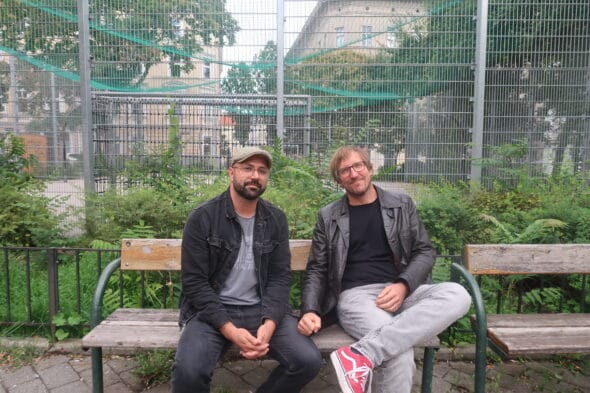
So you guys have been mixing cultural events and non-profit community work for a long time now?
Tobias Pichler: Yes, for example at that event not only did I play soccer, but I was also involved as a DJ. And Martin organized the event together with Stefanie.
Martin Schlögl: Yeah, and then there was another big project called Soko Danub.

Tobias Pichler: That was really hardcore fun!
Martin Schlögl: Yeah, we translated one episode of an Austrian TV series called Soko Donau into Arabic with people from Syria. And we screened it and it became something of an educational and cultural program, mixing things that don’t usually come together. That was in 2015…
Tobias Pichler: Yeah there was a discussion going on at the time about, not only refugees, but in general, immigrants coming to Austria having to learn this “Austrian spirit”. And we asked ourselves: ‘How? And why?’ So we came up with this idea about taking this series, which somehow gives an idea of the culture here and wanted to translate it to give people, new to Austria, a kind of feeling for the language and culture. We didn’t take it all too seriously, but it turned out to have an impact.
Where was it screened?
Tobias Pichler: We were invited by This Human World – International Human Rights Film Festival, and had the premiere at Metro Kino.
Martin Schlögl: Yeah, then there was a nice documentary about it. And this was then screened in several Arabic-speaking cities. So people ended up watching this Austrian TV show in Arabic around the world.
Tobias Pichler: And all the actors came and got in touch with us and met the Syrians involved. So the whole thing really grew. It actually won some prizes at some underground festivals as well.
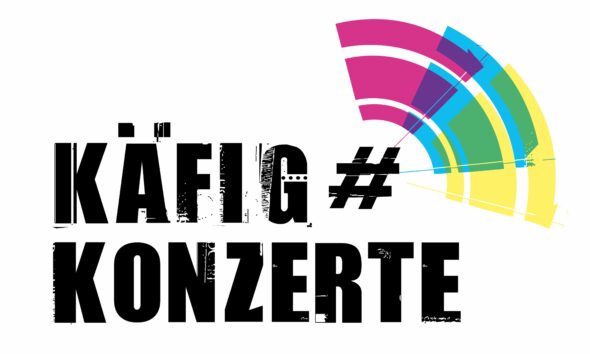
So, following these projects, how did you come up with the idea for the Käfigkonzerte?
Tobias Pichler: As with most things, when we meet up and talk about ideas, it’s usually not just one thing. We talk about some situations, feelings and events. And then we mix them up. Plus, we have this office here together, and right in front of us is this basketball cage (Henriettenplatz in the 15th district), which we constantly see.
Martin Schlögl: … And always hear the sound of.

Tobias Pichler: Yes, and Martin has worked together with a composer (note: Rudolf Wakolbinger) on the large-scale sound-installation, “Expansion of the Universe” which deals a lot with sounds and clangs – specifically, 216 loudspeakers. And so we thought about how we can get involved with this type of work ourselves. I guess this was the start.
It’s something of a “sociotope” – a meeting place for all kinds of people, cultures, ages and purposes. And it’s necessary.
But additionally, the idea grew out of the place itself – a public sports cage. It’s a very important space for people. Even before the pandemic, they use it as a meeting room, a living room, a place for escape. It’s a space for loving, chatting, arguing. It’s something of a “sociotope” – a meeting place for all kinds of people, cultures, ages and purposes. And it’s necessary.
Moreover, we really want to be integrative. We never wanted to say, ‘hey, we’ll use the cage as a sound laboratory today, please go home.’ No, we want exchange – to go into “someone’s” place, and use it for us, but do it together. And, well, we hope it works. Sometimes things go more easily, sometimes not. But it’s important to try.
Speaking of when things haven’t always been easy, what are some challenges you’ve faced in the development of this project?
Martin Schlögl: The technical process to make the cages have a good sound is not as easy as I thought. It really requires some serious work to make it effective. We had our first attempts in 2018, and another in 2019, from which we could learn and improve from. And now with this current series, we can really say the output is satisfying.

Tobias Pichler: Yes, because it should sound “real”. Many people may expect a huge “wow” effect, and they may be disappointed. But we also don’t want to interact or intervene so much. So we try to find a good mixture, and a balance.
Martin Schlögl: I mean you could also fake it, and have the outcome be that it sounds like a bomb hitting every time you pound the cage. But that hasn’t been our aim.
Tobias Pichler: Yeah, but now we actually play with this a bit – with some effects. At first we were somehow afraid to use too much technical modification. But now we are a bit more open to this.

So it’s a learning process.
Tobias Pichler: Definitely. Also with the help of our colleagues and the musicians involved, like, for example, Lukas König, who has been a great support with his sound expertise. He is also doing the workshops with us, and that has also helped us to learn more about possibilities. And the other challenging thing was…
Martin Schlögl: … the pandemic!
It’s been a long process and has required a lot of flexibility
Tobias Pichler: Yes, it wasn’t so easy to get in touch with people in the community as we had originally hoped. Initially we had the idea to bring together big groups of people from the area – associations, schools, etc. And finally we had to reduce everything, and go step by step. We had to go into the community, instead of bring it to us, and ended up creating the Käfig Stories (note: narratives centered around sports cages and the community) and workshops. In the end I think we were still able to create something with the original vision and purpose. But it wasn’t possible to engage the neighborhood as much as we had planned. So instead we leaned into the Käfig Stories, photo projects and other forms of engagement. We decided our headline is the cage and with that lens, we will engage as many individuals and organizations as possible who can connect to it.

It’s been a long process and has required a lot of flexibility. I think really the biggest challenge was to keep up the energy and good vibes through this difficult time, because we always had to find a new plan, new strategy and new partners.
Martin Schlögl: But in the end, we made it. And we have now directly integrated the pandemic into the whole concept.
How so?
Martin Schlögl: For example, we figured out that during the pandemic, another use of the cages was taking place. There is a group of people that we work with who are disabled, and the facility where they have their daily structure was closed. So all of the activities they had, took place in one of the cages in Vienna. And this is something we tried to “catch” and became one of the “Stories”.
So the Käfig-Stories developed by picking up on the organic manifestations of the cages?
Martin Schlögl: Yes. Also, this was a big turn for us – deciding we will take this pandemic into our concept, and try to communicate about it directly.
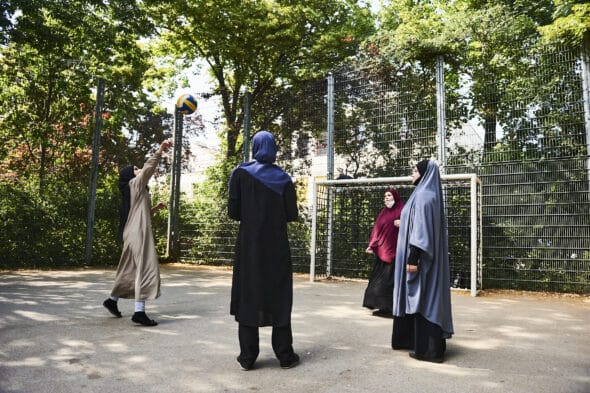
Tobias Pichler: That’s right. This is how the project has evolved. Originally we wanted to provide the infrastructure for the community to show up and present themselves. But this turned out to not be possible during the pandemic. So in the end, we have shown their stories – their backgrounds, their work. We do it in documentary-style with podcasts, photo series, etc. This is one thing that we were able to do in smaller circles, and keeping in line with the regulations and reality of the situation at hand.
Martin Schlögl: Yes. Also our financer – the SHIFT program – has luckily been very open for these changes, allowing us to go another way, to modulate things and be “on point” to what is really going on.
Tobias Pichler: Yes, the pandemic is now part of our project, even if it was certainly not in the original pitch. We don’t want to make it the center of it all, but we don’t want to ignore it either. But at the end of the day, all the artists and creative people are forced to create during a pandemic. So that’s really a special and genuine issue. You always have to keep it in mind, because it’s just the reality we face. And it’s ok if you sometimes struggle and run out of energy. I mean, look at us – we have been meeting multiple times a week, staying up till (at least) midnight since months, working on this. Often when we thought we had found the thing, then, again, conditions changed and we had to reinvent concepts, over and over. Sometimes you have to find a positive way to work even when things are not so.
Challenges upon challenges. The concerts should have happened in spring, but they were cancelled?
Martin Schlögl: Yes, the April, May and June events were cancelled/postponed.
But you were able to hold some events in summer. What did those look like?
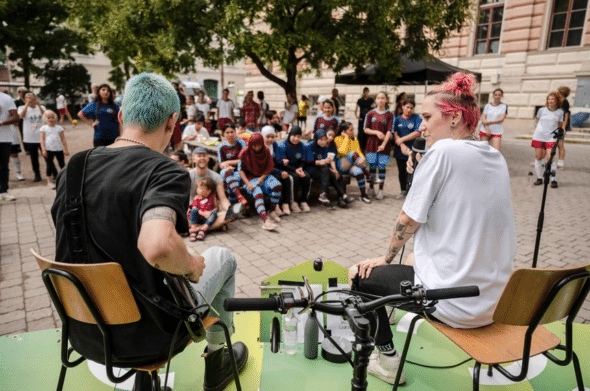
Martin Schlögl: There was a mix. On one hand, using the cage for soccer events for girls – the Girls Cup. There also was a workshop with Lukas König, where people could figure out how to make music with ordinary things, as well as with a prototype of the cage.
And then there was a surprise-concert with Amy Wald, especially for the participants of the Girls Cup. And that really was a great pairing. Amy Wald, besides playing music, was then playing soccer with the girls, as well.
Tobias Pichler: It was really special. She was very open-minded and the exchange was fantastic. For those summer events, we had to be flexible and play it safe. So, although we had to cancel a lot of shows in spring, we made sure to plan things which were more or less certain to occur in summer – if anything, just to keep the spirit of the project up.

Martin Schlögl: It was very important for our mental health, as organizers, that something happened. And it turned out great. It was important for us that the people involved could go home at the end and say it was a worthwhile and fulfilling experience. And I think that’s what happened.
Tobias Pichler: Yeah it’s also important that it’s always free of charge and open to everyone, and that we keep it simple. So there was no pressure about audience numbers, because we didn’t know what was possible due to the pandemic. In the end we just wanted to be able to offer about 100 girls, mostly with refugee backgrounds, the possibility to use this situation and space in a positive and enjoyable way.

Regarding the upcoming concerts, how did the program come about? Did you curate it yourselves? And if so, how did you come up with this notably, musically wide-ranging lineup?
Martin Schlögl: Yes, we made the lineup. We were in the great situation that we could really take the time and look deeply into the Austrian scene and check out the current players.
Tobias Pichler: Some might say, we could have made things easier for ourselves.
How so?
Tobias Pichler: I mean, we know a lot of musicians. And we could have just asked them to perform.

Martin Schlögl: Right, but we went the more inconvenient route and said, the criteria is really simply, does the music hit us? If we know them personally or not, has no importance. This was a really nice process, because what I learned is that currently there is so much great music happening in Austria – well-made, well-produced, from really interesting characters. And another thing that was really nice to see was that without any kind of intentional curatorial influence, there turned out to be so many female artists in the program. There was no preconceived notion about this. No quota or goal or anything. We really just focused on the music. Nevertheless, the result was that 70% of the artists at the end were female. This was a very nice moment when we realized this.
Tobias Pichler: Yes and I would say the second step was we somehow had to figure out if they really understood or could appreciate the idea. It was very important that artists not only see it as a paid gig, but as a project.

To see if they actually care about it.
Tobias Pichler: Yes, I mean there was no pressure that any artist had to be more involved in the project than just playing a gig. But it turned out that many did anyway. Regardless, I can say that most of the artists really showed genuine interest in the project, and thereby carry the spirit of it.
Technically speaking, do all of the performers play with the cages, or do some just play in them?
Martin Schlögl: Yes, well..
Tobias Pichler: Should we “spoiler” this?
Martin Schlögl: Ah… ! (laughs)
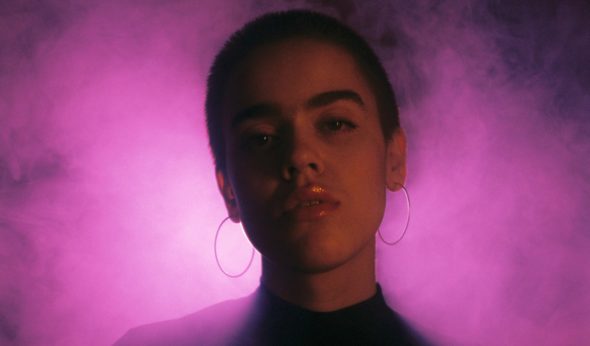
Ok, so it’s mixed. Then, maybe you can at least tell me if there was any instruction? Or could everyone have their artistic freedom?
Martin Schlögl: We really worked it out with the artists individually. We had no concept which we imposed on anyone. We talked to the artists and listened to them, and really figured out how they could best fit into the project. And this was the part of the work which was very…
…Time consuming?!
Martin Schlögl: Yes! (laughs) It was a little bit crazy to do it like this. But really nice things came out of this process.
With all of this “personal care”, and the notable give-and-take, I am curious if this aspect of social investment will translate into the final product of the concerts. As in, will we, the audience, be able to “feel” the “love”?
Tobias Pichler: Perhaps it wasn’t part of the original concept, but this should be how it works in the end, hopefully.
Are the workshops and concerts specifically related to one another?
Martin Schlögl: The workshop is divided into two parts. The first will be done by Alexander Forstner. The people attending the workshop will learn how to make music out of ordinary objects. The second part will be done by Lukas König, where he is building on his first workshop to create an artistic performance – a music piece, with the workshop participants at the concert.

As an intro to his performance?
Tobias Pichler: Well, actually, in our view, there will be no opening bands or main acts or anything, in general. For us, all the artists are at the same level.
Martin Schlögl: Right. Our aim is that there should be one piece of music. Within these 60-75 minutes, there should be a logical, fluid, uninterrupted arc of music.
Tobias Pichler: This was the next challenge.

Martin Schlögl: Yeah, we don’t want there to be a break. It should be one piece of music at each cage concert. There are different musicians and characters involved, but, ultimately, they all connect and come together to make one piece of music.
Ah, ok, this is a surprise. And, no doubt, a challenge. Now I’m even more intrigued.
How have the neighbors reacted to all of this? “Community outreach” is a buzzword which is sometimes easier said than done, out of both logistics and emotions. And, well, Viennese are not exactly known for their neighborly warmth and hospitality. (laughs)
Martin Schlögl: Well, let’s see what happens! (laughs) But, so far so good. Our experience here in our hood has been very positive. We’ve had no problems, because the people know and trust us, and have seen the work we have been doing over the last years.

Tobias Pichler: Yes, that’s also a reason why the program is compressed. Because what we may perceive as sound and music, others may perceive as something they don’t want to have around too long. So we have to be respectful.
Well, how else can a city evolve than to be challenged now and then?
Tobias Pichler: Sure, but at the end, you’re right, outreach is difficult. And we don’t know what will really happen, so we try to stay flexible. At the same time, however, we try to create a kind of a spirit before the concerts start. So the neighborhood sees what is happening, and is given a chance to get into it, through various points of entry (food, kids programs, exhibitions, etc.). The set-up itself gives a lot of space and personal choice – if you pass by and like it, you can stay and take in more of the event. If you don’t like it, you can keep going. It’s no big deal.
It was originally planned as a big community event. We have had to reduce it unfortunately. But still, hopefully the neighbors and police will realize it’s a good thing and give it a chance.

Was this inspired by any other projects? Have you seen anything like this elsewhere?
Both: No, not really.
Could you imagine taking this to other places? Exporting it, so to speak?
Tobias Pichler: Our first idea was to play in every cage in Vienna. (laughs) No, I’m joking, there are like…
Martin Schlögl: … 200 cages in Vienna.
Tobias Pichler: Yeah, no, but at least the dream is to play in every district in Vienna. Then challenge number two: In every bigger city in Austria. And challenge number 3: In other cities in other countries. We’ve talked about Berlin for example. At the end, it would be nice if we could repeat this in cages, but actually the most important elements are sound, community, platform, etc. I mean, if there is no cage, but another public space which is important to that that area, it would be enough.
There is something ironic about the title “cage” because it doesn’t only bear associations of openness and liberation, but can also indicate holding one captive; or generally creating boundaries, which seems more or less the opposite of your concept. On the other hand, a cage offers a place of protection or security, depending how you see or use it. So, a good deal of ironies and paradoxes in there.
Martin Schlögl: Yes, it’s true. It’s an interesting thing. The young people go out to the cages to free themselves – to release energy, to socialize, to do all sorts of things that they are not allowed to do outside of that space. So the cage – as I learned in the Käfigstories – is a place of freedom. It’s really a peculiar, particular and very interesting phenomenon.

We want to use this spirit for the concerts – that there is something inside the cage which people from the outside can look into. And the communication goes back and forth. As a viewer you get to have an inside look into the social fabric of the cage.
Adults tend to lose their ability to “play”. With this project, however, it seems that adults are given the opportunity do so in the workshops, or simply be invited into a more playful environment in combination with highly regarded music and culture.
Martin Schlögl: This is a very important point – that it is open for everyone and not this so-called “high culture” thing, which is usually very exclusive. It is always interesting and important for us to combine elements which are not meant to be connected at first sight. Similarly, the Wiener Symphoniker have made a program called “Open Symphony” which is their music education program. It used to be called “Young Symphony” but they’ve now consciously expanded to all kinds of demographics and ages. Their project, which also includes outreach programs in the city, new concert formats, etc., is perfectly in line with our concept, and so the collaboration has been able to grow. We see a lot of potential here.

What would be the perfect outcome of the Käfig events?
Tobias Pichler: If I may give you an answer which comes spontaneously from the gut: I have a picture right now in my mind from our event in 2019 which drew a really great mixture of local neighbors and, well, hipsters. And there was an interview done by the ORF where they spoke to the janitor of a school and she said it was so cool what they do here, and we love it that they are here. And I was really blown away, with some tears in my eyes. I thought – this is exactly how it should be. Be open, be present, like it or not – we should all have freedom and the chance to connect.
this is a personal objective for me – that people get in touch with the things that I myself burn for – sound, and expression via sound
Martin Schlögl: I think for me, if it really happens that this set of diverse musicians really come together to make one piece of music, this will be awesome. And then, if people can get exposed to certain types of music that they don’t usually listen to, or don’t think they like, but turn out to become more open to it in the end – if this kind of musical and cultural expansion and exchange can occur, that would be great. This is a general aim I have. If this project really brings music to people, in a meaningful way – that would be my ideal outcome. As a musician myself, or as a music teacher – this is a personal objective for me – that people get in touch with the things that I myself burn for – sound and expression via sound. If more people get in touch with this, I think this is a good thing.

Also, there are all kinds of different people involved in the cages project – various NGOs and associations which are doing really good work for the city – but they are not usually known or acknowledged.
So the cages projects are making some invisible things, visible.
Martin Schlögl: Yes! Bringing representation to the unrepresented and the invisible, visible.
Tobias Pichler: And we want to bring long-term effects. The Käfigkonzerte will all be documented and remain online. And we also are looking for exhibition spaces for the Stories and Photo Series. If we can give the artists platforms after the fact, that would be great.
Finally, it would be really nice if every evening is very different from the next, but you shouldn’t have any thoughts about which one was the best.
A fine ideal to end on. Thank you for the conversation.
Arianna Fleur
Links:
